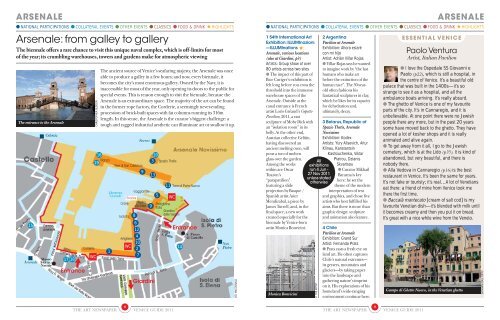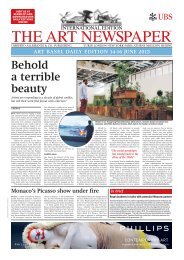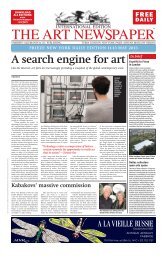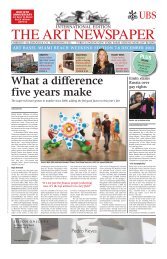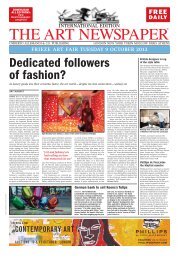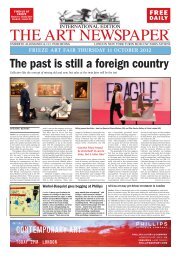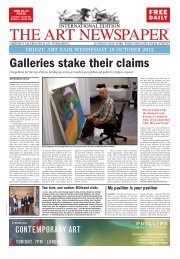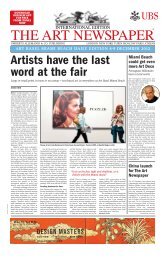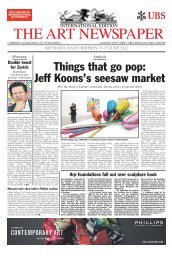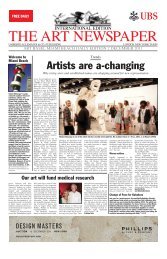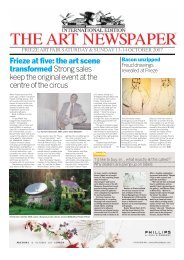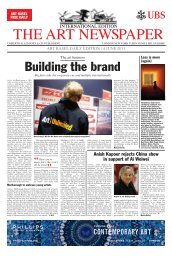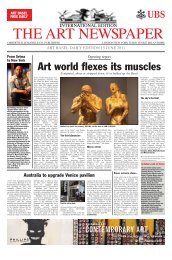BIENNALE GUIDE 2011 - The Art Newspaper
BIENNALE GUIDE 2011 - The Art Newspaper
BIENNALE GUIDE 2011 - The Art Newspaper
You also want an ePaper? Increase the reach of your titles
YUMPU automatically turns print PDFs into web optimized ePapers that Google loves.
ARSENALE<br />
● NATIONAL PARTICIPATIONS ● COLLATERAL EVENTS ● OTHER EVENTS ● CLASSICS ● FOOD & DRINK ★HIGHLIGHTS<br />
Arsenale: from galley to gallery<br />
<strong>The</strong> biennale offers a rare chance to visit this unique naval complex, which is off-limits for most<br />
of the year; its crumbling warehouses, towers and gardens make for atmospheric viewing<br />
<strong>The</strong> entrance to the Arsenale<br />
15<br />
17 18<br />
Entrance<br />
Corderie<br />
CHRISTOPHER SEDDON<br />
WC<br />
<strong>The</strong> ancient source of Venice’s seafaring majesty, the Arsenale was once<br />
able to produce a galley in a few hours; and now, every biennale, it<br />
becomes the city’s most enormous gallery. Owned by the Navy, it is<br />
inaccessible for most of the year, only opening its doors to the public for<br />
special events. This is reason enough to visit the biennale, because the<br />
Arsenale is an extraordinary space. <strong>The</strong> majority of the art can be found<br />
in the former rope factory, the Corderie, a seemingly never-ending<br />
procession of brick-built spaces with fat columns running its 316m<br />
length. In this sense, the Arsenale is the curator’s biggest challenge: a<br />
tough and ragged industrial aesthetic can illuminate art or swallow it up.<br />
16 20<br />
Nappa<br />
19<br />
Tese di San Cristoforo<br />
3 Spazio <strong>The</strong>tis<br />
1<br />
Gaggiandre<br />
Snacks<br />
5<br />
WC<br />
Crane Teatro<br />
alla Tese 9<br />
Padiglione<br />
Italia<br />
Giardino<br />
Isolotto 8<br />
delle Vergini<br />
<strong>Art</strong>iglierie<br />
WC<br />
10<br />
2<br />
8<br />
THE ART NEWSPAPER VENICE <strong>GUIDE</strong> <strong>2011</strong><br />
6<br />
12<br />
4<br />
7<br />
9<br />
13<br />
Giardini<br />
11 Torre di Porta Nuova<br />
Entrance<br />
14<br />
VICI MACDONALD<br />
1 54th International <strong>Art</strong><br />
Exhibition: ILLUMInazioni<br />
—ILLUMInations ★<br />
Arsenale, various locations<br />
(also at Giardini, p3)<br />
<strong>Art</strong>ists: Group show of over<br />
80 artists across two sites<br />
● <strong>The</strong> impact of this part of<br />
Bice Curiger’s exhibition is<br />
felt long before you cross the<br />
threshold into the immense<br />
warehouse spaces of the<br />
Arsenale. Outside at the<br />
canal entrance is French<br />
artist Loris Gréaud’s Gepetto<br />
Pavilion, <strong>2011</strong>, a vast<br />
sculpture of Moby Dick with<br />
an “isolation room” in its<br />
belly. At the other end,<br />
Austrian collective Gelitin,<br />
having discovered an<br />
ancient melting oven, will<br />
pour a ton of molten<br />
glass over the garden.<br />
Among the works<br />
within are Oscar<br />
Tuazon’s<br />
“parapavilion”<br />
featuring a slide<br />
projection by Basque /<br />
Spanish artist Asier<br />
Mendizabal, a piece by<br />
James Turrell, and, in the<br />
final space, a new work<br />
created especially for the<br />
biennale by Venice-born<br />
artist Monica Bonvicini.<br />
2 Argentina<br />
Pavilion at Arsenale<br />
Exhibition: Ahora estaré<br />
con mi hijo<br />
<strong>Art</strong>ist: Adrián Villar Rojas<br />
● Villar Rojas says he wanted<br />
to imagine work by “the last<br />
humans who make art<br />
before the extinction of the<br />
human race”. <strong>The</strong> 30-yearold<br />
often fashions his<br />
fantastical sculptures in clay,<br />
which he likes for its capacity<br />
for dehydration and,<br />
ultimately, decay.<br />
3 Belarus, Republic of<br />
Spazio <strong>The</strong>tis, Arsenale<br />
Novissimo<br />
Exhibition: Kodex<br />
<strong>Art</strong>ists: Yury Alisevich, <strong>Art</strong>ur<br />
Klinau, Kanstantsin<br />
Kastsiuchenka, Viktar<br />
Piatrou, Dzianis<br />
Skvartsou<br />
● Curator Mikhail<br />
Barazna is key<br />
here: he set the<br />
theme of the modern<br />
interpretation of text<br />
and graphics, and chose five<br />
artists who best fulfilled his<br />
aims. But there is more than<br />
graphic design: sculpture<br />
and animation also feature.<br />
4 Chile<br />
Pavilion at Arsenale<br />
Exhibition: Grand Sur<br />
<strong>Art</strong>ist: Fernando Prats<br />
● Prats casts a fresh eye on<br />
land art. He often captures<br />
Chile’s natural extremes—<br />
its geysers, mountains and<br />
glaciers—by taking paper<br />
into the landscape and<br />
gathering nature’s imprint<br />
on it. His explorations of his<br />
homeland’s wide-ranging<br />
environment continue here.<br />
9<br />
THE ART NEWSPAPER VENICE <strong>GUIDE</strong> <strong>2011</strong><br />
ARSENALE<br />
● NATIONAL PARTICIPATIONS ● COLLATERAL EVENTS ● OTHER EVENTS ● CLASSICS ● FOOD & DRINK ★HIGHLIGHTS<br />
Monica Bonvicini<br />
All<br />
exhibitions<br />
run 4 Jun -<br />
27 Nov <strong>2011</strong><br />
unless stated<br />
otherwise<br />
© THE ARTIST<br />
ESSENTIAL VENICE<br />
Paolo Ventura<br />
<strong>Art</strong>ist, Italian Pavilion<br />
● I love the Ospedale SS Giovanni e<br />
Paolo (p22), which is still a hospital, in<br />
the centre of Venice. It’s a beautiful old<br />
palace that was built in the 1400s—it’s so<br />
strange to see it as a hospital, and all the<br />
ambulance boats arriving. It’s really absurd.<br />
● <strong>The</strong> ghetto of Venice is one of my favourite<br />
parts of the city. It’s in Cannaregio, and it is<br />
unbelievable. At one point there were no Jewish<br />
people there any more, but in the past 20 years<br />
some have moved back to the ghetto. <strong>The</strong>y have<br />
opened a lot of kosher shops and it is really<br />
animated and alive again.<br />
● To get away from it all, I go to the Jewish<br />
cemetery, which is at the Lido (p35). It is kind of<br />
abandoned, but very beautiful, and there is<br />
nobody there.<br />
● Alla Vedova in Cannaregio (p16) is the best<br />
restaurant in Venice. It’s been the same for years.<br />
It’s not fake or touristy; it’s real…A lot of Venetians<br />
eat there: a friend of mine from Venice took me<br />
there the first time.<br />
● Baccalà mantecato [cream of salt cod] is my<br />
favourite Venetian dish—it’s blended with milk until<br />
it becomes creamy and then you put it on bread.<br />
It’s great with a nice white wine from the Veneto.<br />
Gampo di Ghetto Nuovo, in the Venetian ghetto<br />
GIOVANNI DALL’ORTO


